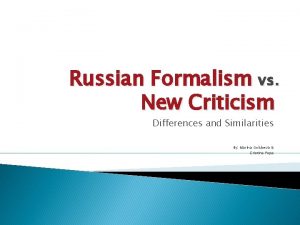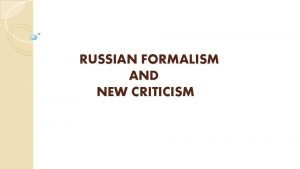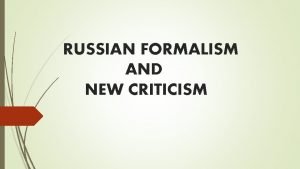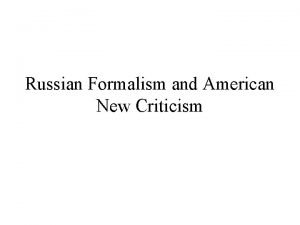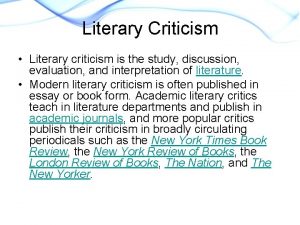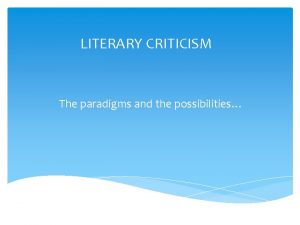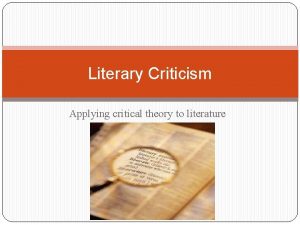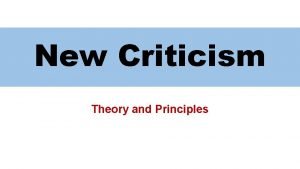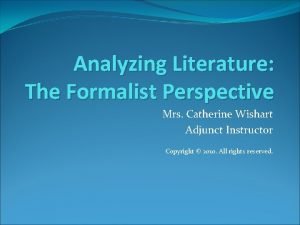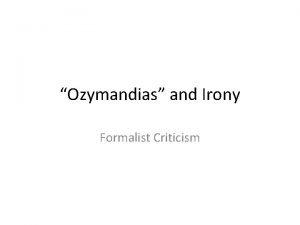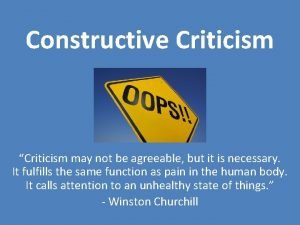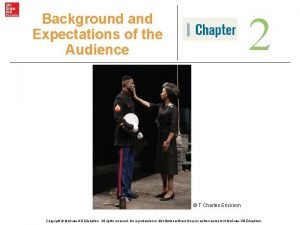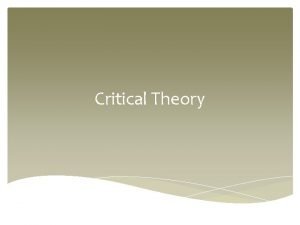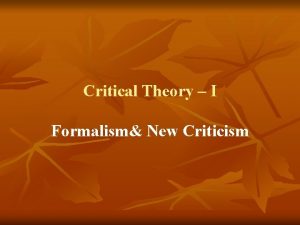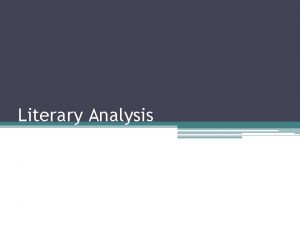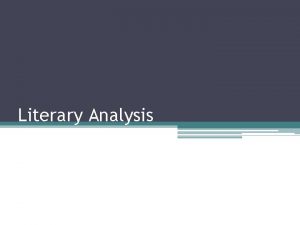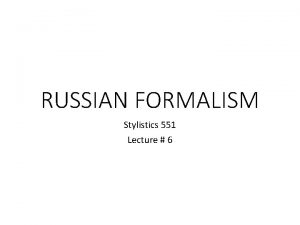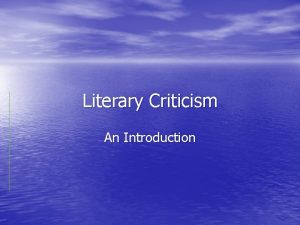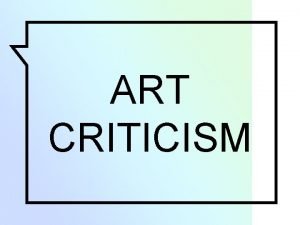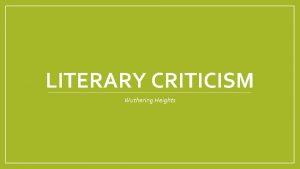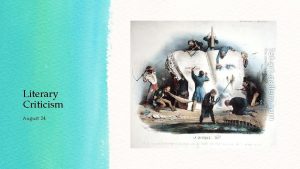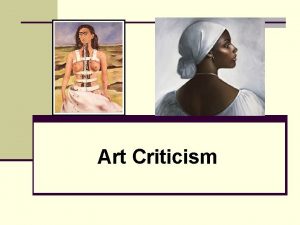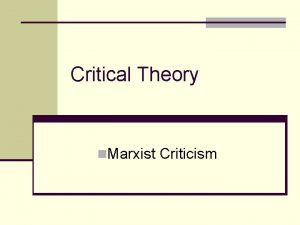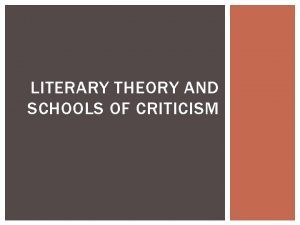Critical Theory I Formalism New Criticism Introduction Formalism

















- Slides: 17

Critical Theory – I Formalism& New Criticism

Introduction Formalism: Historical Development Moscow Linguistic Circle – 1915 ØOPOYAZ (The Society for Studies of Poetic Language) – Viktor Shklovsky – 1916 ØPrague Linguistic Circle – 1926 – Roman Jakobson and Petr Bogatyrev ØNew Criticism Ø The Chicago School or Neo-Aristotleans Ø

Backgrounds for Formalistic Theory n n n Plato - Preoccupation with Form Aristotle – “orderly arrangement of parts” Coleridge – Imagination as a Shaping Power Poe – “the heresy of the didactic” Henry James – “fine art”

Key Concepts Ø Ø Ø Shklovsky – The sum total of all stylistic devices employed in it Literature – special use of language and deviates “practical language” – literariness Defamiliarization – “ostranemie” Organic Unity Shape and Experience are Functions of Each Other Local Texture and Logical Structure

Key Concepts (Contd. ) Ø Ø Ø Ø Imagery and Symbols Intentional Fallacy and Affective Fallacy Point of View Tension Plot and Story Poiesis and Mimesis Bound and Free Motif

Key Concepts (Contd. ) Ø Ø Literary Works – dynamic systems in which elements are structured in relations of foreground and background Bakhtin – language or discourse as a social phenomenon

New Criticism Ø Ø Ø Anglo-American traditions in the 1920 s complex and contradictory Arnold – the influence T. S. Eliot , I. A. Richards, F. R. Leavis, William Empson – key figures Cleanth Brooks – a major formalist critic

Key Figures and Concepts T. S. Eliot Ø Ø Ø Objective Correlative Scientific Disinterested Defamiliarization Impersonality Poetry – escape from personality

F. R. Leavis Ø Ø Ø “scrutiny” “discrimination” Canon is exclusive and hierarchical Validation based on taste, preference and partiality 1960 s – “gothic”, “popular fiction”, “women’s writings” - neglected

I. A. Richards Ø Ø Ø Practical Criticism Democratisation of Literary Study “blind text”

William Empson Ø Ø Ø Ø Ambiguity as the defining poetic language Metaphor Opposites making a new idea Pun Freudian Slip Unfortunate confusion Fill it in Tension too big to tame / Binary Opposition

Wimsatt and Beardsley Intentional Fallacy Ø Affective Fallacy Ø

Ransom and Brooks Ø Ø Ø Ø Criticism must be scientific and accurate Students must read literature and not about literature Organic elements are important Literature is not about a few rhetorical devices Irony, tension or paradox alone do not make a poem Strict attention to form and a conservatism to classical values Structural tightness

The Chicago School n n n Neo-Aristotleans R. S. Crane and Wayne C. Booth – key figures Aristotle’s concept of plot, character and genre Logic, lucidity and scrupulous concern More than language and diction, structure or form gains significance

Limitations Ø Ø Ø Ø Only poetry could be analysed better Literature cannot be separated from society Literature cannot be dissociated with author, history and psychology Marxism subordinates literature to society Aesthetic value is determined by the elite Undervaluing genres other than poetry Hunt for literary devices, overlooks feelings and emotions

Select Reference Texts Ø Ø Ø Eliot’s Tradition and the Individual Talent F. R. Leavis’ The Great Tradition I. A. Richards’ Practical Criticism John Crowe Ransom’s The New Criticism Robert Penn Warren’s Understanding Poetry and Understanding Fiction

Conclusion: Summary n n n n Formalism –Historical Developments Backgrounds Key Concepts & Figures New Criticism Key Concepts & Figures The Chicago School Limitations References
 Formalism literary theory
Formalism literary theory Formalism and new criticism
Formalism and new criticism What is the difference between new criticism and formalism
What is the difference between new criticism and formalism American new criticism
American new criticism Feminist criticism example
Feminist criticism example Critical semi critical and non critical instruments
Critical semi critical and non critical instruments Semi critical instruments in dentistry
Semi critical instruments in dentistry Reader response criticism
Reader response criticism Theory of literature notes
Theory of literature notes Discuss the principles and methodology of new criticism
Discuss the principles and methodology of new criticism Examples of peripeteia in hamlet
Examples of peripeteia in hamlet What is formalist perspective
What is formalist perspective Formalist lens
Formalist lens Biblical criticism is not a form of historical criticism.
Biblical criticism is not a form of historical criticism. Constructive vs destructive criticism
Constructive vs destructive criticism Descriptive criticism vs prescriptive criticism
Descriptive criticism vs prescriptive criticism Critical theory in criminology
Critical theory in criminology Critical reading meaning
Critical reading meaning
